|
'Tis the Season for Seasons lol! Stella and Princess Buttercup finally decided to start their cycles. Ofcourse, typical of pugs, they chose the holidays which is making progesterone testing at vet challenging (since the vet is closed for these long holiday weekends). Nonetheless, we are giving it a college try and hope the timing has been/will be successful! We are so fortunate that some amazing pugs will be available to us as studs ... one in Canada, one in New York, and another incredible boy close by. If omicron, mail deliveries, and progesterone levels cooperate, and if mars aligns with venus, lolz, we hope to have some of our best litters yet. We'll be updating the pages with developments.
0 Comments
Finally, a day off of work so I had time to re-read old books and scour new books and videos in my seemingly never-ending quest to learn more about proper structure and movement. Thank you, incidentally, to several breeders for your input and chats and answers to my questions. Perhaps it's because I'm a former dancer that I'm so fascinated with movement in dogs and the ramifications a fault in structure (like, as a dancer, a low arch, or too short of legs) can have in the ultimate flow and grace of movement. Or, perhaps it's just that I appreciate the 'art' of the dance and beautiful motion in any animal or human, like with this dog . . . . The motion is smooth. There's no jarring in the shoulders or thighs. "Because of the dog's good head carriage, strong working back, and correct tail set, you see a beautiful topline. Rear thrust is transmitted smoothly through the stifle, loins, and central body, and is counterbalanced by the cushioning effect of the forelimbs. There is no jarring in the shoulders or thighs. It's just a gorgeous picture of symmetry and coordination." (Elliott - New Dog Steps) A similar exquisite "dog in motion" example was when I saw Blanca Clothier's pug, Matthew. He simply floated around the ring. But, sometimes at dog shows, I'm amazed when a judge will seemingly be blinded by a pug's pretty face/head to the point where they don't seem to notice that the pug is crabbing, with legs crossing in the rear, moving too close with stifles out, or moving so close that the legs actually brush in passing, cowhocked, or sickle hocked,, or twisting hocks, or pitching and crossing, or with front legs paddling, (which, hello handlers, we know you're covering up a bad front by stringing the poor pug up so the front feet never touch the ground), or with easty-westy toeing out (pugs are not supposed to stand in 1st position like ballet dancers). I get it, though. A beautiful pug's face is breathtaking. And that look they give you ... who can resist that face? Truly, one day, pugs will rule the world. But they won't get very far if they can't walk. Recently my husband and I were asked by a longtime pug breeder what our goals are as breeders. I responded with "a healthy pug with a beautiful face and head who moves like an amazing dalmation." She said "good luck with that" lol. Obviously, I know that a pug will never move exactly like a dalmation because they are built completely differently, However, whether it's a border collie, pug, or chihuahua, if it's healthy and has 4 legs the dog should be able to move AS FREELY and EFFORTLESSLY as possible for the given build, structure, and purpose. For perspective, this video of Miss Piggy dancing with Nureyev comes to mind . . . Obviously swine were never intended to dance the Nutcracker. .... they were intended to BE the nutcrackers lolz (eat nuts) and grace our dinner tables. (Or crush walls and, yes, I must briefly digress. Did you know that Wall Street began as a picket fence in 1653? At the time, the settlers let their livestock run loose and the hogs often uprooted orchards and gardens. The Dutch Director General describes the "great grief the damages, done to the walls of the fort by hogs [and the] injurious and intolerable destruction which we, to our great dissatisfaction, daily beyond the hogs committing on the newly finished works of the fort, whence the ruin thereof will certainly ensue.") So back to pigs, I mean pugs. Centuries ago, selective breeding strategies had the goal of producing dogs to assist with specific tasks that helped humans survive and thrive. Hunt? Herd? Capture vermin? Be a companion? Alert the guards protecting the monks? (Yep, that was pugs ... all the way back to the times of Confucius). Whatever the animal's purpose/function, the structural components were designed to produce the optimal combination of characteristics to suit the tasks to which each dog was bred to perform. Size. Substance. Skeletal structure. Chest size. Thoracic and pelvic limb angulation. So, while Miss Piggy was not designed to dance Swan Lake and Nureyev was not designed to crush the Wall Street wall, Dachshunds were not designed to pull carts filled with butchered meat to market, and Rottweillers were not designed to dig out prey and go inside burrows. Yes, sometimes they get their purpose wrong ... like our Great Dane thinking she was supposed to be a lapdog (sitting on my mother's lap, or being a couch potato along with her owner and fellow pug Louis) . . . In the book by Martin S. Fischer and Karin E. Lilje, "Dogs in Motion", the authors studied kinematics and kinetics using high frequency videography, marker-based movement analysis, force plates, and biplanar X-ray videography in 327 dogs of 32 different breeds. Here is an excerpt from Dr. Fischer's lecture in 2017 in Boston where he compares a whippet, Malinois, and French bulldog in motion. Dr. Martin is obviously not very brachy breed friendly but, aside from that, these videos are a result of an amazing merge of biology and engineering. "Sound movement" is relative. Sound movement for a greyhound is different than sound movement for a Frenchie. OFA hip results for a greyhound are quite different for a Frenchie (so why are we still comparing them and using the same critera for evaluation and scores?) Again, I digress. Sorry. But nature has designed each joint and muscle to serve a special purpose. As Rachel Page Elliott explains in her books Dogsteps and The New Dogsteps, "Movement, or gait, reflects a dog's physical coordination, balance of body, and soundness. Sound movement contributes to the health and normal lifespan of all dogs. Sound dogs are happier dogs." So, while I know a pug will never truly move 'like a dalmation', I still want to strive as a breeder to produce pugs who have sound movement (for a pug) and are therefore happier pugs (and pug owners) for their hopefully long life. Movement, or gait, reflects a dog's physical coordination, balance of body, and soundness. Sound movement contributes to the health and normal lifespan of all dogs. Sound dogs are happier dogs." Continuing with some more excerpts from Fischer's and Elliott's books, notice in this photo (not a pug ;) how the flexibility of the spine enables the rear limbs to reach way forward beneath the body as the ball and socket action of the hips lets the knee joints swing wide to avoid interference with the ribs. In the photo above, note how the shoulder blade has dropped back as far as the muscles will allow. The upper arm acts as a lever in helping to lift the blade as it swings from its upper edge against the withers. The greater the speed, the more the limbs converge to maintain balance and facilitate propulsion as you see in this video of a Borzoi . . . But in contrast, let's take a look at this lumbering bulldog . . . Bulldogs were bred to be stable so they wouldn't be knocked over by bulls. Yep. As a result bulldogs have a very unique conformation with wide shoulders and a low slung body creates a 'roll' and slight sidewise movement. Recently, our latest bred by Pickwick Puppy 'pick of the litter', Doris (Pickwick's Diamond Doris Breakfasts at Tiffany's) regularly won Best of Breed in her "BPUP" 4-6 puppy competition, and usually won the Toy Group, except for when her main competition, a beautiful Italian Greyhound sometimes beat her. This dog moved so beautifully - had a soulful face that just melted your heart. Yet, thankfully, the judges knew not to compare the glorious free, high-stepping action with good drive of an IG to Doris' pug motion (albeit Doris' side gait is breathtaking). This is not the same IG but, nevertheless, you can see the different in motion between the Italian Greyhound and then Doris. Regardless, there is a natural tendency in all dogs for the limbs to converge to balance the body over a central support. Many dogs single track with all feet landing on or close to a center line . . . Other dogs move with a wider foot fall, like this corgi . . . Here are some video clips of our Grand Champion, Robert (GCH CH Hill Country's I'll Bee Your Shining Star), and 2 of our current pugs in the show ring, Lilibeth (Pickwick's Show the World How to Smile), and Doris . . . Robert is an exceptional pug and his amazing breeders have some of the highest standards I've ever seen. They do all health testing and will not keep a pug in their breeding program if it does not meet their high standards. As a result, most of the pugs you've seen on TV over the past decade at the Westminster Dog Show have been their dogs (JJ, Rumble, Biggie etc.) or offspring of their dogs (2021 Tony) etc. So, it's not surprising that Robert did exceptionally well on all his health testing we finally completed not long ago after he turned 2 years old. Alas, though, as perfect as Robert is though, he's not perfect. Yep, it's true, a 100% perfect dog does not exist ... unless it's computer generated by Fischer and his team lolz. There will always be at least one flaw. Robert has THE most amazing, mink-like, clear, plush, coat, yet he could use more pigment on his face and ears. He could use more reach and drive when moving, yet these are small things when compared to serious flaws. For example, you will never see any of these scenarios of poor rear movement when watching Robert from behind . . . Here are 3 puppies from the same litter. One of them does not have the best rear movement. Can you tell which one? A very experienced breeder told us not to give up on this puppy and to let her grow out before deciding if she should remain in our breeding program. Sure enough, after maturing, this hint of cow hock disappeared almost entirely. She is breathtakingly beautiful, with a clear, light coat, short back, square and cobby build, tons of bone, and an amazing topline which has held up even after her first litter. Her front is perfect. So, we are glad that we gave her a chance and held onto her. But this leads me to the question .... how do breeders choose which flaw to ignore and when to ignore it? Longtime breeders have explained that this is where the "art" of breeding plays emerges. There are so many pieces to the puzzle. What were the flaws of the parents, grandparents, and great grandparents? How serious was the flaw? Will this flaw be correctable within a generation or two by choosing appropriate mates? Is this flaw life-threatening or will it compromise the quality of life in their offspring? The point of this blog is that I personally feel that movement has to be at the top of the list and a quintessential goal, yet I can't tell you how many times I've heard outside the pug ring at dog shows (from pug owners, handlers, breeders) when remarking on poor movement, "well, it's a pug". If the remark was simply a commentary on a pug's unique movement ... wider foot fall, the infamous pug roll etc...that's one thing, If the remark is an effort to excuse sickle hock or a wide front in a pug who crabs or paddles to the extreme that the handler has to string up the pug, then I don't agree because I know it's possible for a pug to have fluid movement and, again, Blanca Clothier's pug Matthew floating around the ring comes to mind. There is great truth in the old saying "As a dog moves, so is he built". As a dog moves, so is he built." One longtime breeder on the east coast told me her goals were "more bone, plush coat, beautiful soft face". Another very important breeder/handler/judge in eastern Europe told me his goals were "short back, high tail set, good angulation". Another breeder in Texas has a rule that "3 strikes and you're out" which perhaps applies more for conformation and shows versus breeding. Regardless of their goals, every breeder will interpret the breed standard differently and will have a unique hierarchy of criterion when realizing their interpretation. Traveling through time . . .I'm so thankful to many breeders who have taken time to share insight on pugs of the past with me. I've spent countless hours chatting with these generous people, many of whom have long since retired from breeding, as I learn the 'inside scoop' on many pugs from many generations back .....the great, great grandparents and even great, great, great, great grandparents of our pugs. One very famous pug who shows up in a lot of current day pug's pedigrees was S/S for PDE. (Of course, this was before they had tests for PDE gene markers.) Another had limited pigment (according to rumor, his face in the famous Westminster win photo was "painted on"). Another had issues with topline , and on and on. But, the only way to make the past come alive is to speak with people who SAW these pugs in MOTION, who had their hands on the animal to feel the structure, or who saw the offspring and what the dog produced. Or someone, who spoke with someone who spoke with someone. Here is the pedigree of our Miss Dior (CH Pickwicks' Child, That Hemline's Out of Sight, TKN). Without these discussions, these names would just be names. In searching for a stud for any of our girls, we have to make the pedigree come alive and somehow "see" these great, great, great grandparents in motion, "hear" them breath, "feel" their structure. For example, here is an amazing pug, Samich, (BISS RBIS CAN GCH/AM CH/MBIS UKC CH Siosalach's Hammin' It Up!, CGN) we have been considering for one of our Thrill girls . . . When you study the pedigrees of this boy and some other studs we are considering, you'll find a couple of common ancestors. Like Tupelo's Shoboat to China . . . and the paternal great grandfather of Samich, and our foundation bitch, KK's paternal great great great grandfather, School House Pocket Watch . . . And Tupelo Triple Crown . . . Unless you speak to a human who knew a human who knew a human (etc) you will never know what is truly behind a pug. What were their "1-2 strike(s) and you are almost out" flaws? PK? Movement? Hips? Breathing issues? S/S/ gene marker for PDE?, Allergies? Straight stifles? Steep shoulderblades? Wide front? Topline? Pugs were larger several generations back which, quite honestly, I don't mind. In fact, a pug with some leg under it can actually jump over a log when hiking. While I did hear one story about a breeder about 4 decades ago who would occasionally darken the wrinkles on the face with a black sharpie to make it "pop" more, at least most of these pugs had actual pigment whereas in a recent dog show I saw a handler literally paint on a blob where the 'diamond' is supposed to be and the owner told me the pug literally had blonde/tan ears, so they were completely dyed. However, it seems like there has been more emphasis placed in recent years on movement and, of course, health testing which are newer resources in the last couple of generations. Talking about pugs of the past is one thing. Seeing the pug ... in person ... move around the ring is quite another. If only it were possible to "click" on the photographs of these famous pugs of the 1960s, 70s, 80s etc. to start a video of them gaiting. Even with the best handler in the world, you can't hide many structural flaws when the dog is moving. When choosing studs for our girls we study pedigrees and photos and often fall in love with a boy with a gorgeous face who looks amazing when stacked for the win photos. But sometimes, once we actually see the pug move, we move ... move on that is. Pillage the VillageSo it takes a village. Without a dialogue among breeders it's impossible to make these pedigrees come alive. Yet, I often feel like the sport of conformation might eventually ruin this dialogue. Last month, a professional handler who was in the ring with me whispered under her breath, "if only the judges would stop choosing those damn bred by pugs." Wow. Without breeders, this woman wouldn't have a job. I was entered in the puppy class that day, but the next day I took in my bred-by girl. The handler did seem a bit sheepish at that point as I'm sure she remembered her comment to me from the day before. At any rate, most breeders ONLY enter the dogs they are quite proud of in the bred by class. A point of pride. So, this handler missed the mark on so many levels. Judges often choose bred by because, quite honestly, they are (very often) better representations of the breed. Sometimes, breeders just enter Bred By because they want to earn that amazing AKC medallion. An example of the best intentions gone awry. Another example of the best of intentions gone awry --- the entire sport of conformation. Today it is such a cut throat environment, as evidenced by the tactics this handler finally had to use in order to win, that it is getting in the way of dialogue among breeders. The sport that was created to help preserve breeds is actually getting in the way of preservation of knowledge, history, dialogue, and the community. In order for this handler to finally beat the bred by entrant, she had to step out in front and block the view of the other pug so that the judge only saw the handler's pug who, incidentally, had a horrible topline dip at shoulders plus a roach, absolutely horrible rear movement with legs criss-crossing, and was (not surprisingly) bred by a backyard breeder, (an oopsie on the bitch's FIRST cycle, with the breeder's mother's unaltered male pet pug who just happens to live next door ... actually this pug in the ring was the result of a 3rd oopsie), who does no health testing and, of course, is not concerned with pedigrees. I often hear stories from just a decade or 2 ago where exhibitors would pull together and help a specific dog get their major. This involved a ring full of breeders. Today, the rings are filled with professional handlers. It's more competitive. Even if the handlers were to exit the ring leaving only breeders, it's doubtful this sort of scenario would play out today. But with this sort of competitive environment, it's understandable why many breeders are reluctant to speak about health issues in their line, or even speak at all. I can honestly say that there are only a handful of breeders who have been candid with me and helpful. The rest are mostly only concerned with the success of their own line and not the preservation of the breed.. In fact, I heard of one breeder (if this is true) who actually reported another breeder/exhibitor to AKC for unsportsmanlike behavior simply because they were discussing outside the ring with the parent club president some structural problems IN THEIR OWN dog. Not gossip. Just learning. Yet AKC took back the ribbon of the exhibitor who was trying to learn simply based upon this report. As a relative newbie to all of this, from my perspective the sport of conformation shows should be at the service of breeders. But, when the least little discussion is turned into dirty tabloid gossip, it's not a village, it's a pillage. Anatomy 101 (o.k. Anatomy .35)Let's turn the discussion back to more tangible things now, though, before this blog turns into an article from a 1980s National Inquirer. Let's talk about bones, muscles, and ligaments. Always in pursuit of learning, I'll sometimes name all the parts of my dogs when giving them their bath. Perhaps we could use one of our latest superstars in the show ring, Doris (Pickwick's Diamond Doris Breakfasts at Tiffany's) as a model: Here's a better image from the Pug Illustrated Standard which you can find on the Pug Dog Club of America's website . . . A well-structured dog has limbs that extend freely (reach and drive) and a balanced body so that it can trot long hours without tiring (i.e. a sled dog). Dogs that are built well can stand long days of hard work ... like sled dogs. If a dog is proportioned well, the strong loins lend suppleness to the back and strong pasterns and thick pads help reduce the shock of sudden impact. Strong hindquarters provide strength for quick bursts of speed and thrust for leaping. As you can see in these next photos, Doris was a buckin' bronco at her first dog show she was SO excited to see the judge ... so we see here that she has strong hindquarters lol! After her glorious bounding and leaps on the down and back (when she was supposed to be trotting elegantly), Doris planted a stack (of course, alas, not captured by this photographer) and says to the judge "hello, my name is Diamond Doris, who are you? And why were you rattling that candy wrapper behind your back? Is that perhaps a treat you are unwrapping by chance?" Doris' first cousin, Lilibeth, also liked to leap to the judge in her first beginning puppy shows. Here is an excellent example of an aussie . .. Set well into himself, the neck merges gradually into the withers and the good breadth across the forequarters indicates desirable layback of the shoulders which is counterbalanced by a similar slope of the arms which places the elbow correctly against the chest wall. There is also good width across the thighs demonstrating strong hind quarters. Ultimately you want an overall picture of symmetry and balance, with each 'end' capable of doing its share of the work . . . Length of bone and relationship between the scapula and humerus determine the placement of the elbow against the chest wall. This will vary with different kinds of dogs. Shoulder layback, or the angle of the scapula, can be determined by feeling along the scapula spine that runs up the center of the blade. Bones/Joints in motionForelimb movement is the result of scapula rotation and translation along the body. In this next video excerpt from a symposium presented in 2017 in Boston by Martin S. Fischer, you can see how the skeleton, muscles, and locomotion fit together. In particular, look at the elbow joint and notice how they are NOT moving in locomotion. The dog in the video is trotting at a decent speed. Look at the shoulder joint -- touch down and lift off are almost the same. Based on the results of the largest-scale study on the subject ever carried out, an experiment that involved over 300 dogs and 32 different breeds, the book delivers completely new insights into the motion sequences performed by dogs. The accompanying DVD (without sound-files) features over 400 movies, X-Ray movies and 3D animations and demonstrates both the variety and uniformity of dog locomotion with unparalleled precision and clarity. Here's another clip from the lecture . . . The Importance of Angulation"Angulation" is the structural features that govern balance and the ability to move freely. Angulation has to do with the slant of the bones and size of the angles at certain joints. Good angulation means effortless stride and smooth action. In general, when a dog is standing naturally, the shoulder and stifle joints will have similar angulation, as in these photos from the Illustrated Standard which can be found on the Pug Dog Club of America's website . . . Why is this beautiful? With the neck "well set on", it all merges beautifully with the strong withers at the base of the neck ... and this creates a smooth transition into the back. But if the shoulder blades were too upright, or if the withers were flat, it would be a more abrupt juncture at the base of the neck ... or perhaps too long back, especially the dog also has a steeply set rear). Here is this same dog moving. Notice how he trots with ease and good foot timing as the fore paws lift just ahead of the oncoming hind paws. But a dog could be "balanced" in that both angles are too straight. However, this will cause poor movement, like with this dog. Because he lacks angulation (in both ends equally) his stride is short and bouncy . . . Compare that dog in the last video with this next one. Suddenly Gelsey Kirkland emerges to the stage (the amazing ballerina who danced with Baryshnikov on the famous Nutcracker ... among other ballets). Let's look at that gorgeous pug again . . . . . I can't stand pugs that look like linebackers with no necks. I know it's the uniforms and this football player actually has a neck, but you get my point. With pugs (all dogs), there is a connection between a dog's length of neck and the steepness of shoulders. A beautiful pug who has a beautiful neck has well laid-back shoulder blades, whereas a short necked dog usually has steep shoulders. Steep shouldered dogs appear to have short necks because the distance between their head and their shoulders seems shorter than usual (another favorite book I re-read today ... K-9 Structure and Terminology by Edward M. Gilbert and Thelma Brown.) Here is the requirements from the Illustrated Standard which can be found on the Pug Dog Club of America's website . . . . Unlike the beautiful pug above, some pugs can have loose shoulders if the shoulder blades are too steep and set too far forward. The neck then looks short and the pug won't be balanced so it will have movement problems like rocking, crossing, paddling, toeing in, or other issues to deal with. We will talk more about structural problems that interfere with movement again in a bit, but first let's look at another beautiful pug who we hope to use as a stud for one of our girls in an upcoming planned litter. As a performance dog, Spyder also has so many agility and other titles AFTER his name (and of course a "Grand Champion" GCH prefix). Yes, he has an incredibly beautiful face ...... But he can also move ... Spyder's breeders/owners/handlers live in upstate New York. "You can't breed a head . . . ."A very experienced pug breeder/vet once told me at a dog show in Florida, "you can't breed a head." I was discussing my concerns about our Macintosh, who had just won Best of Breed (again) and was about to finish his championship out of the puppy class. Our first bred by champion, Macintosh has such a beautiful face/head . . . But, alas, he is too straight in the stifles and his rear assembly is just not good. After he finished his championship, he also ended up growing too long and didn't have the temperament we would love to see perpetuated in our line. So, he is now neutered and, to the dismay of many pug breeders who wanted to use him as a stud (because they probably had not seen him move ... only seen his gorgeous face and head), he is not part of our's or anyone's breeding program. A lot of small things add up to big things when it comes to structure. But, hey, maybe God made him just a little too long so that he'd be good at the "push the cart" trick!!! The natural gaits . . .The term gait means "pattern of footsteps at various rates of speed, each pattern distinguished by a particular rhythm and footfall." Some commonly recognized gaits . . .
The 2 gaits in the show ring are walk and trot. Here is an excerpt from the Illustrated Breed Standard regarding proper gait in a pug . . . These are 3 puppies out of the same litter. Two of them had better rear movement than one who was a bit cowhocked. Can you tell which ones they are? When things go wrong . . . .Compare these 2 German Shepherds in this video. Which one seems to move more effortlessly? Which one is struggling? With the first dog, energy forces are directed straight forward through stifles, loins, and central body into the shoulders. But with the 2nd dog, you see that the shoulders jar and pound, the back roaches, and its body twists (sidewinds) as the rear feet step to one side or the other to avoid hitting the front. The 2nd dog would also often 'pace'. It turned out that the 2nd dog, after being x-rayed, had severe hip dysplasia, a bone disease which ccccan cause gaiting problems. In contrast to the balanced doberman we saw before, notice that this next one lacks balance because she has more angulation behind than in front, and she looks "leggy". Notice that at the base of her neck there is an abrupt juncture with flat withers. The ribcage does not extend well back and the coupling looks weak. The steeply set shoulders and upper arms reduce breadth across the forequarters, narrowing the base of support in contrast to the rear. As a result, front mobility is restricted and thrust from the more angulated rear forces the forelimbs into full extension too high above the ground. This upsets the rhythm of footfall and causes over-reaching, where the hind feet overstep the front. This dog will often pace to help avoid the awkward overstep. Let's talk about bad fronts now as so many of the pugs in the top 10 (or let's even say top 5!) have horrible fronts (hence the handlers stringing them up so the front feet hardly touch the ground.) Padding: is a compensation for a front that is out of balance with the rear. You'll see an upward flipping of to delay footfall.... And, another bad "p" word when it comes to poor front movement . . . paddling, which occurs when the front legs are set too far apart. We could be here all day with things that go wrong with motion so perhaps that could be a "part b" to this blog but, all of this pondering is just circling back (without padding, paddling, or pacing) to the fact that a dog who moves poorly is either dealing with a) injury or strain; b) poor assembly and conformation; c) or the viewer is wearing the wrong glasses. If it's b, then most likely the dog will not age as well and might even have to deal with lameness at some point in its life. I know that my own 'conformation issues' are not playing out well as I age (bad knees, hips etc.) but, then again, my mother and father didn't do hip and knee health testing and didn't have a Chic #. 🤣In fact, I wasn't even planned at all! I was an oopsie as they say. But, I'm thankful they had me nonetheless as I've enjoyed my 58 days on this earth to-date .... and, on that note, I'm going to go hug and kiss all of my pugs and you should, too.
5 lucky pugs got to travel with Amy to the WinterWonderland Dog Show Cluster in Perry, Georgia the first week of December, 2021. From youngest to oldest: Parker, Doris, Lilibeth, Robert, and Lilly (Doris' mom). Lilibeth scored a bunch of points and now just needs one more major win. Sadly, the show superintendent, Foy Trent messed up and recorded the wrong dog as winner so hopefully we can get them to respond to our emails and phone messages to get that corrected. Then perhaps we'll finish this championship! Here is Lilibeth after winning Winners Bitch and Best of Winners on Friday (and she also won on Tuesday as well as Reserve Winners Bitch on other days): This AKC dog show was huge with so many entries, yet he still came out winning the pug breed and 2nd place in the Toy Group! The amazing Italian Greyhound who Doris had been competing against (and a few times beat) ended up winning not only 1st place in the toy group but also best in show. But Doris said, "I'm moving up to 6-9 Puppy Class, so you're on your own Parker. You've got to beat that IG yourself now!" (l-r Doris, Lilibeth): Doris did SO much better with her walking (ahem, her owner finally had some time to work on training with her at the show) and she won her class each day plus "Reserve Winners Bitch" to her cousin Lilibeth several days. While there are some good photos of Doris moving, (thank you Phyllis Ensley photography for your exceptional photography and capturing the "real moments" of a dog show), my favorite are the 'out-takes' like when she spots a treat on the floor .... hilarious! She held her stack on the examination table and even looked at the judge lol like her aunt Miss Dior, who was also a natural show girl and very outgoing: And a few photos to prove that she was much better behaved than in the BPUPs: And also a few photos to prove that she is STILL a puppy and having lots of age-appropriate fun in the ring! Doris says, "you mean I'm not supposed to gallop and hop? But it's SO much fun!!" Lilibeth's brother/littermate, Pickwick's Casanova in Disguise (Luke) also won Winners Dog and Best of Winners a few days as well: And here Doris is saying hi to the judge (well, she's supposed to have 4 feet on the ground but she forgot that memo). Cheyenne Tippens did an amazing job showing this fun and energetic puppy. When we were in the ring together (Lilibeth and Doris for Winners Bitch, and then later Casanova and Lilibeth together for the Best of Breed competition, they were totally fine being together. Sometimes they can be 'extra naughty' when siblings are nearby.) Parker rocked his first "BPUP" (4-6 Month Puppy Class) at his first dog show! He was so happy that his tail wagged the entire time, even on the examination table while the judge was going over him. Lilibeth won the Bred By Class and Winners Bitch and Best of Winners on Tuesday and Friday, and reserve Winners Bitch the other days. And Doris won Reserve Winners Bitch at her first 'official' show 6-9 puppy class when Lilibeth won. Lilly, Doris' mother, won the American Bred class on Friday and Saturday and she was a total trooper putting up with being shown again after being a mama (and hating HATING dog shows). And, Robert completed the last of his health testing at Blue Ridge Imaging and the Eye vet so we will be getting that final chic number for hime shortly once we file that final paperwork. Here are some photos from the week. Doris saying hello to the judge:
|
AuthorAmy - Concert pianist, composer, lecturer, teacher, adjudicator, pug lover, dog trainer, soap and candle maker, PawTree Pet Pro, and co-owner Pickwick Pugs along with her husband, Dr. Jeff McLelland who is a concert organist, music director. Archives
April 2024
Categories |
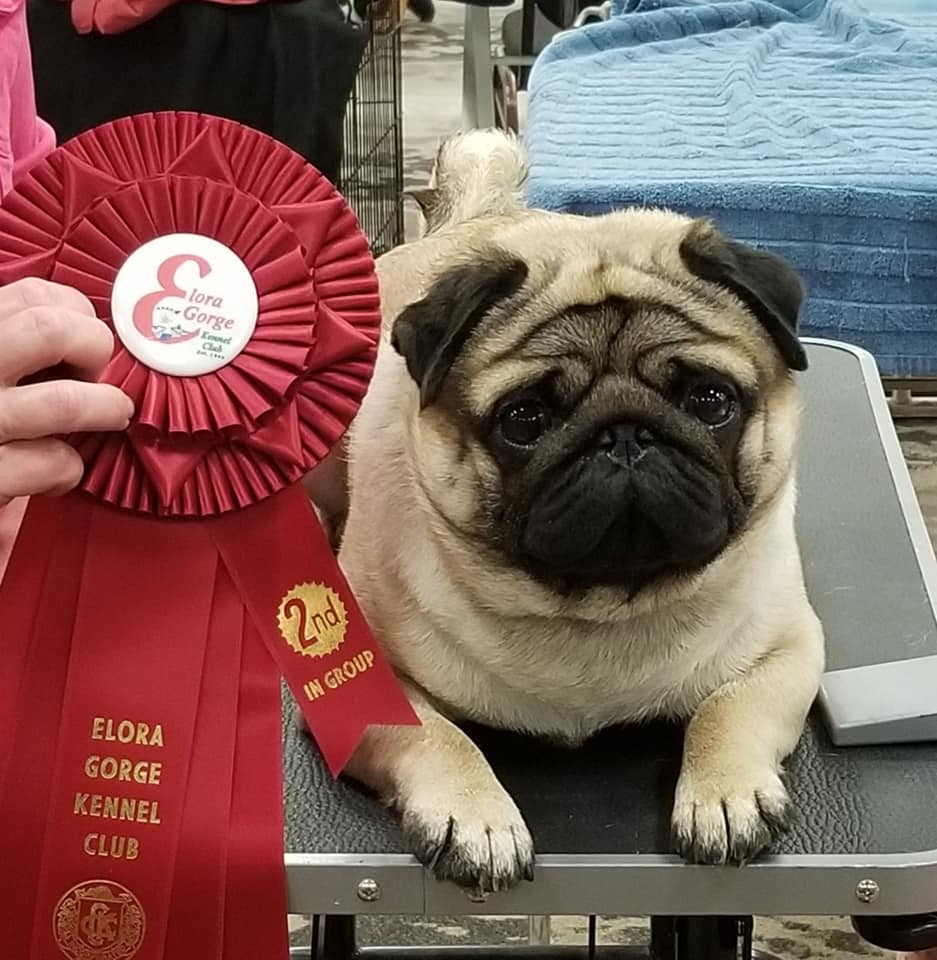
















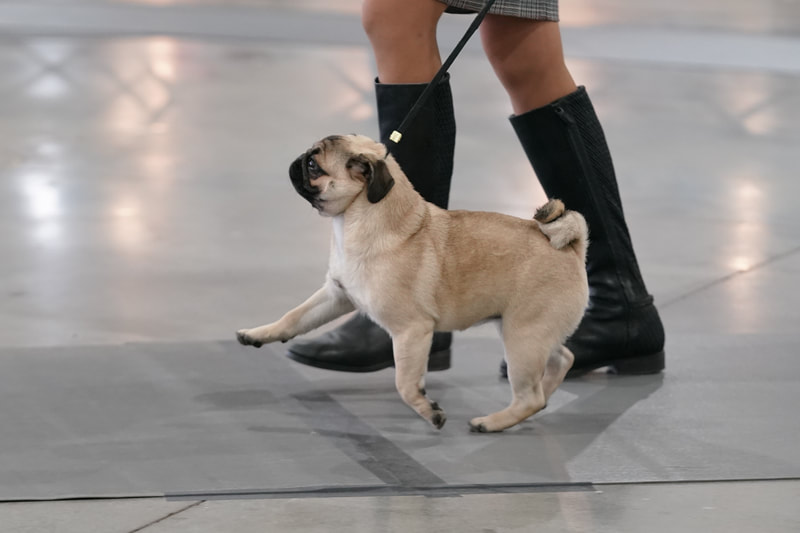


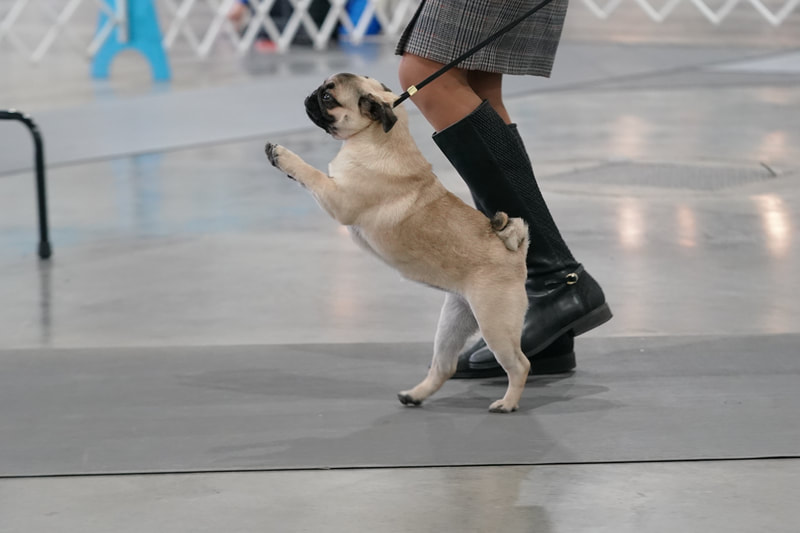
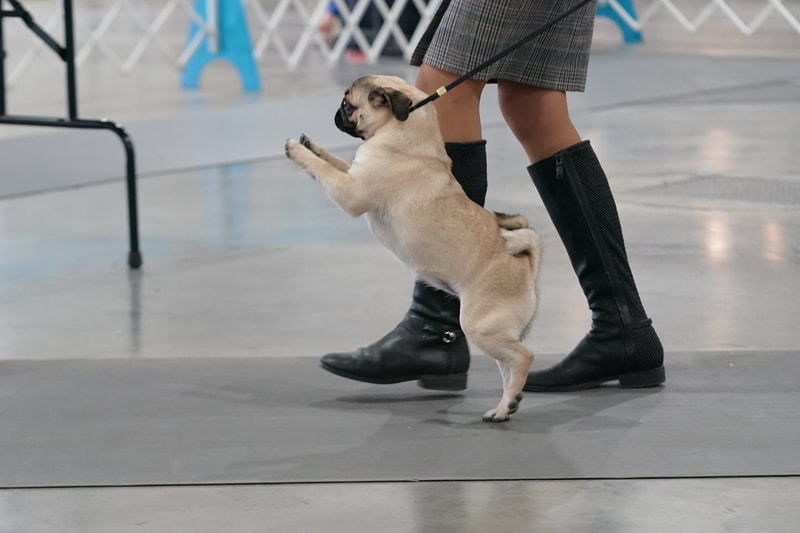




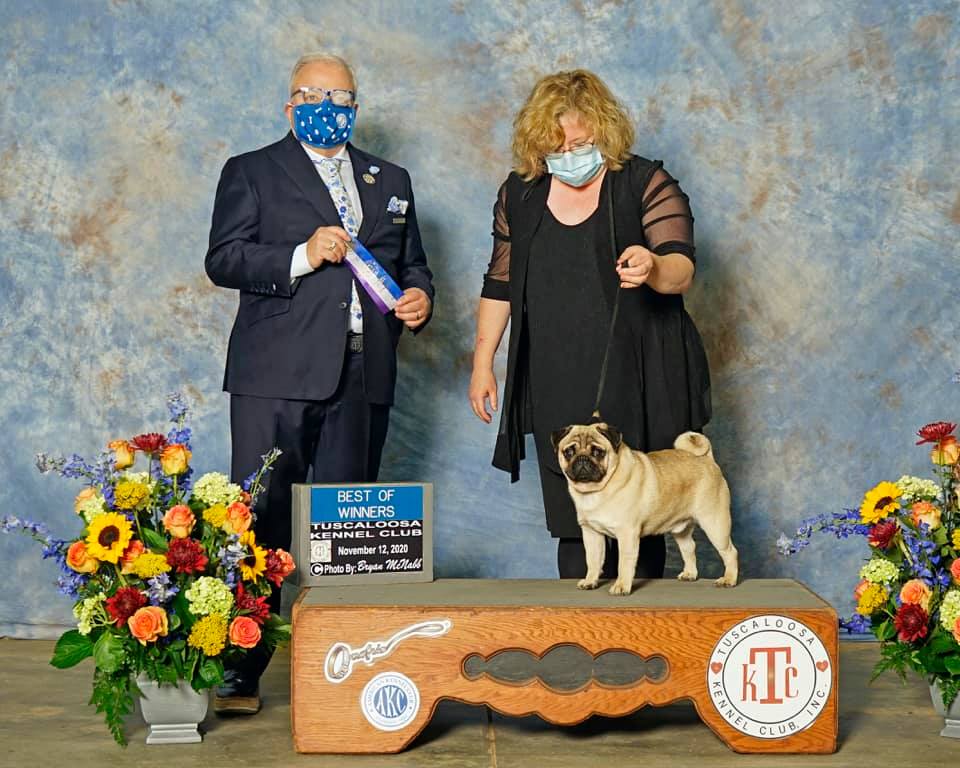


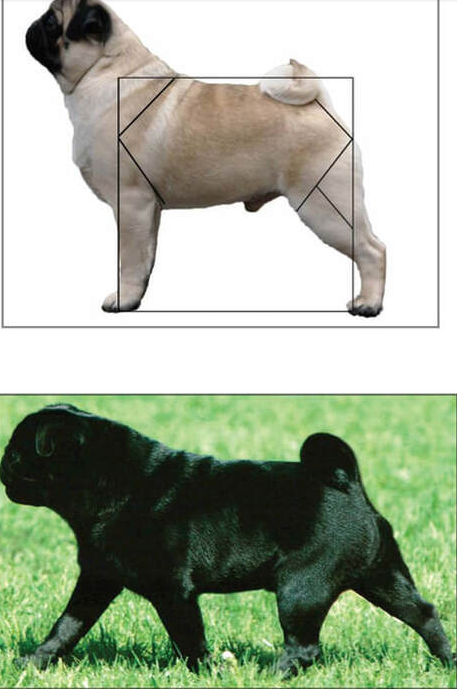
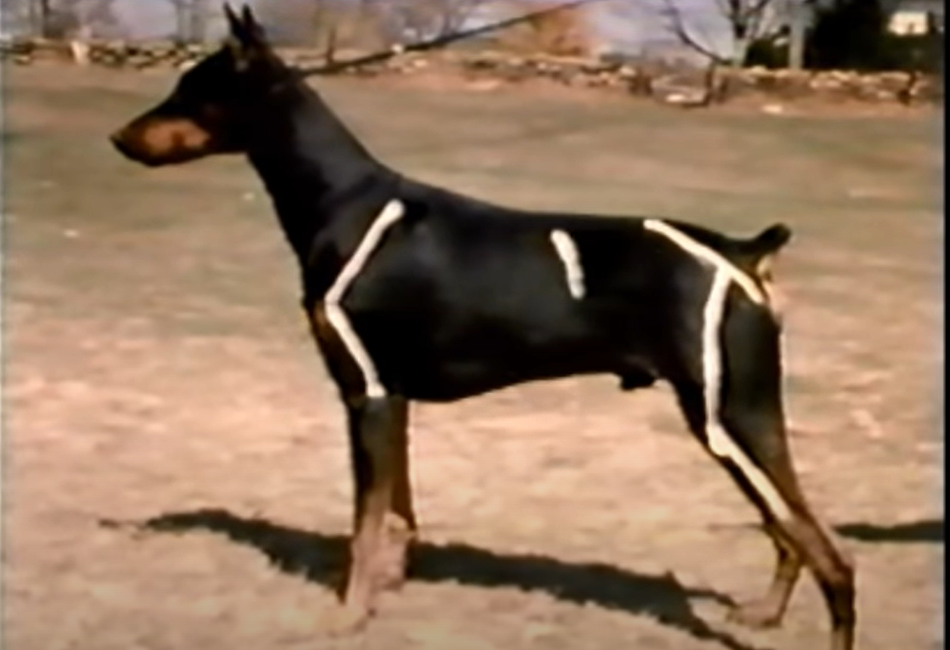
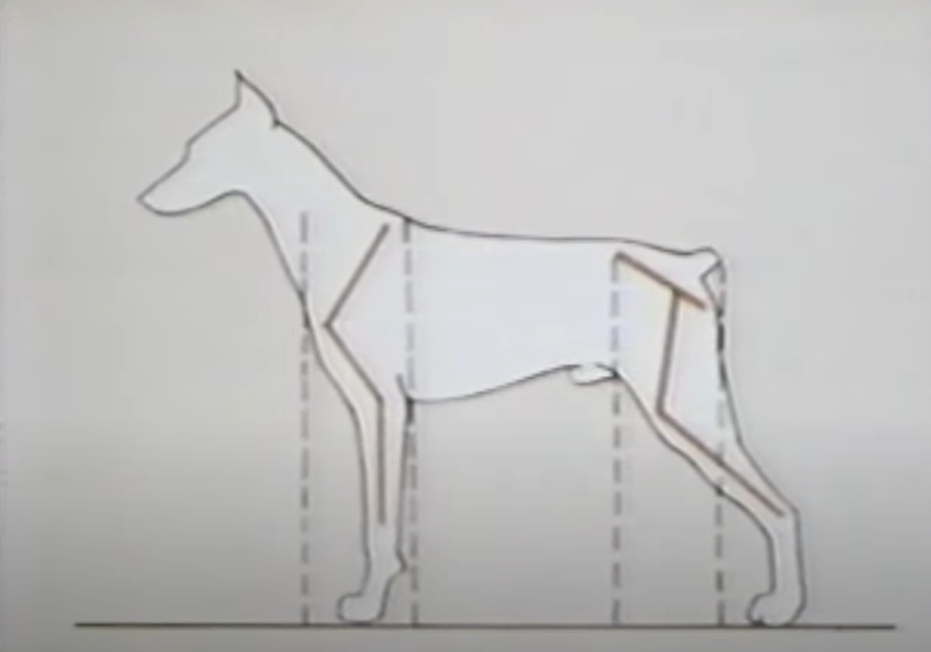

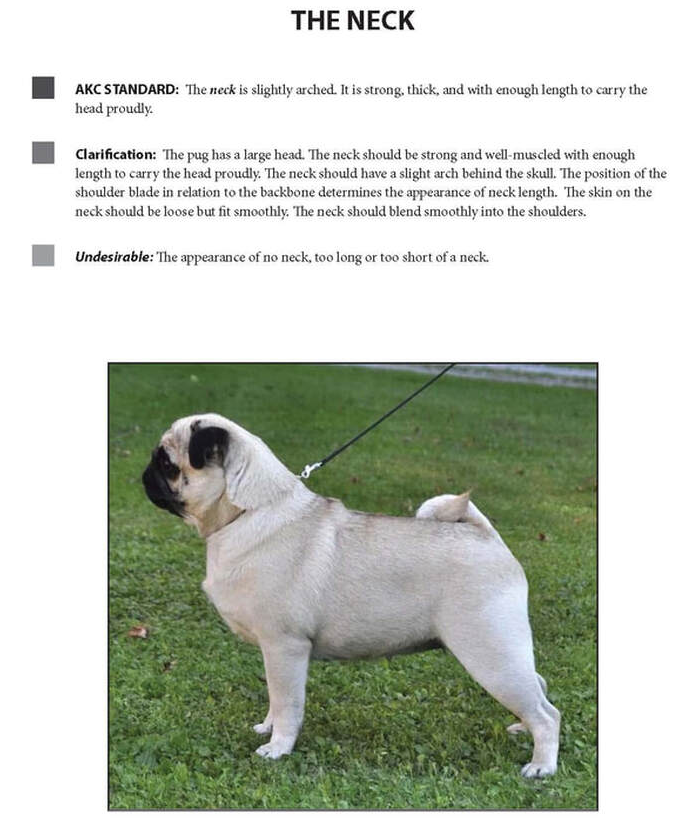

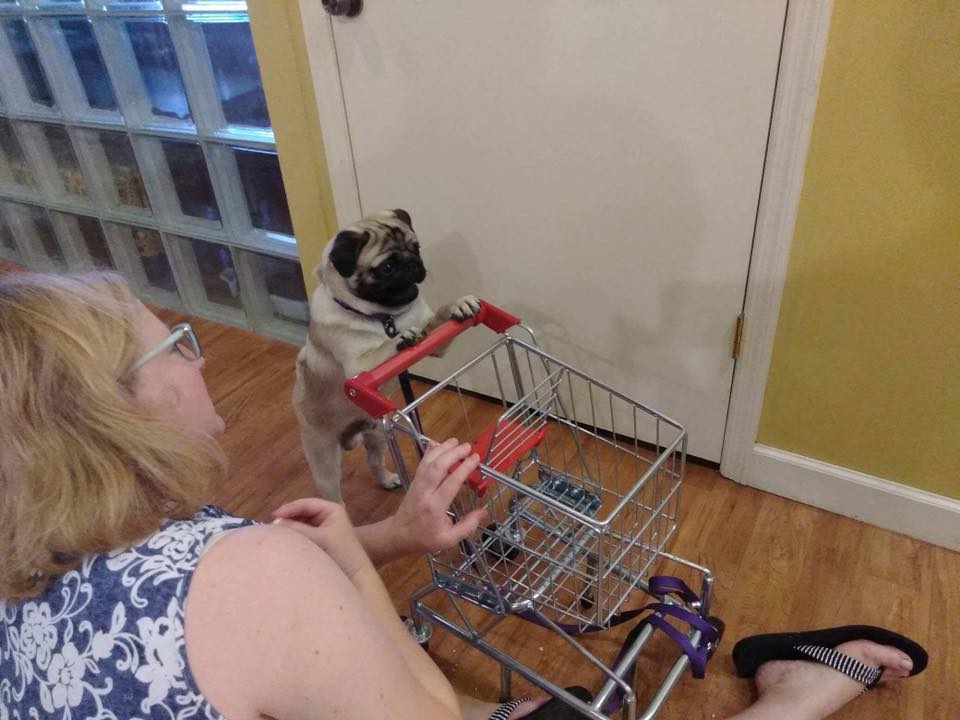




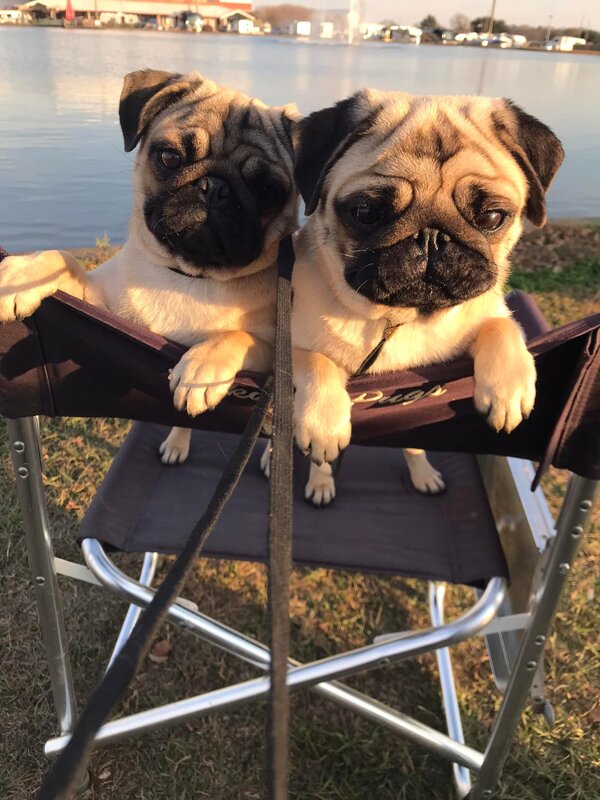




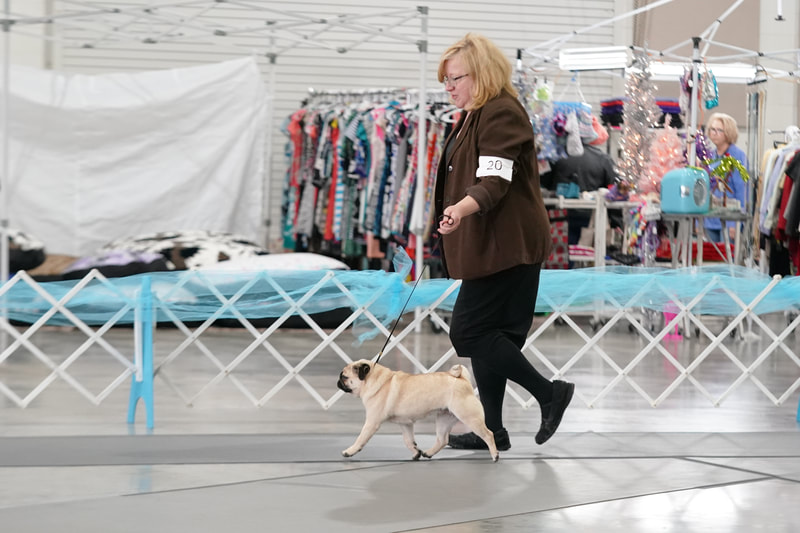




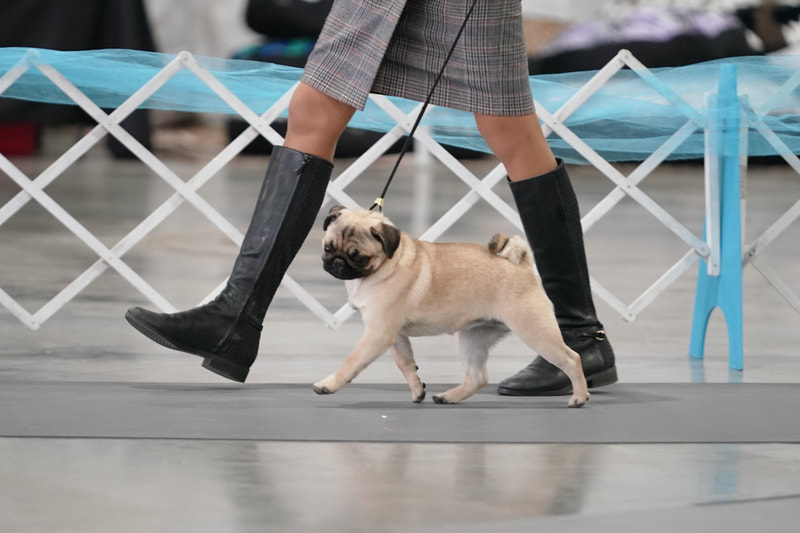
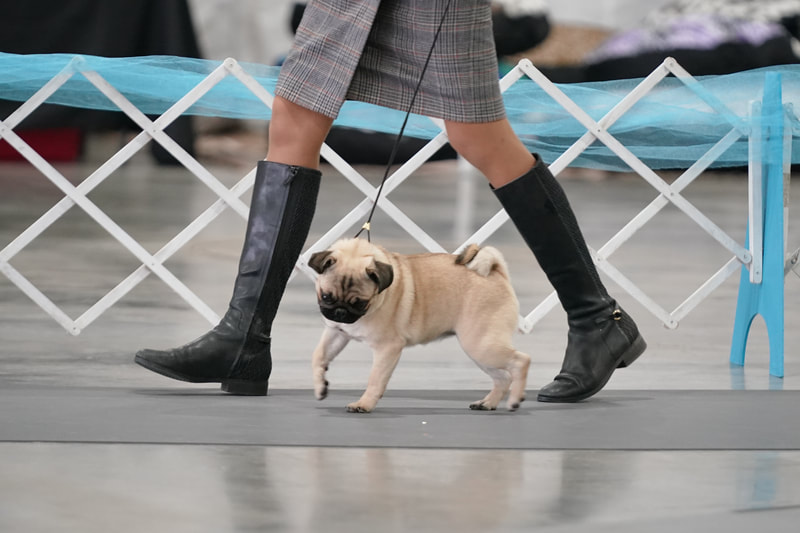
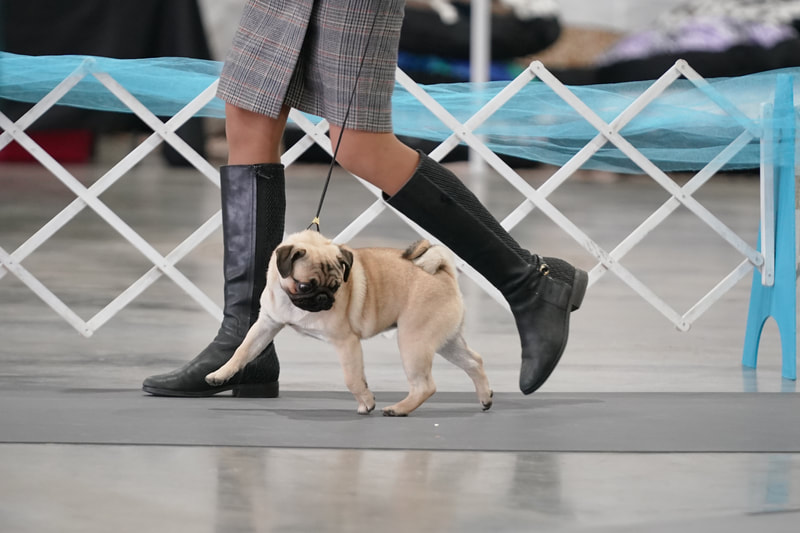


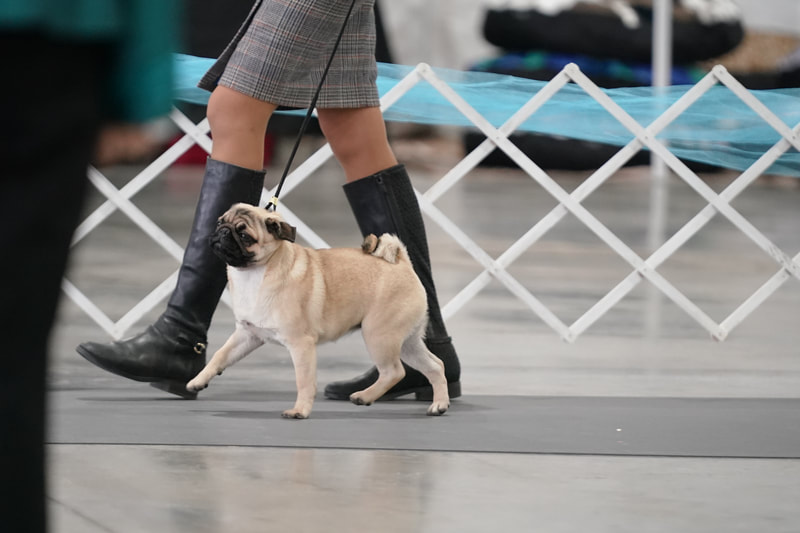



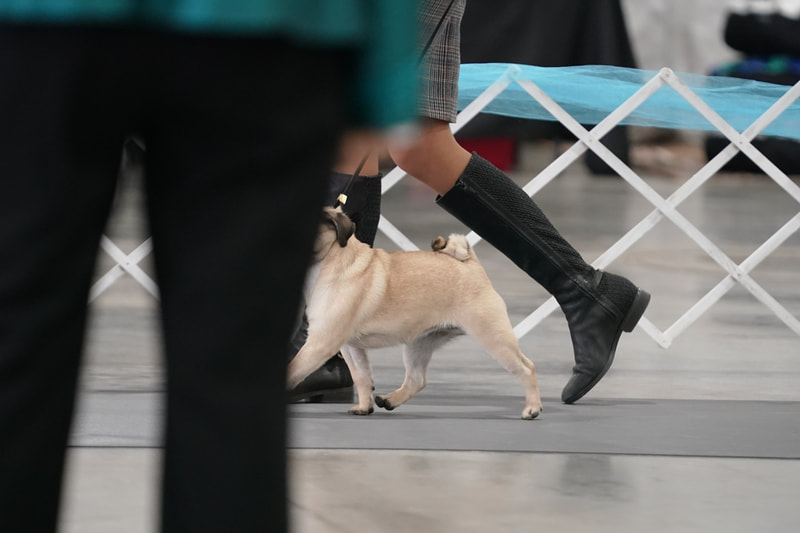









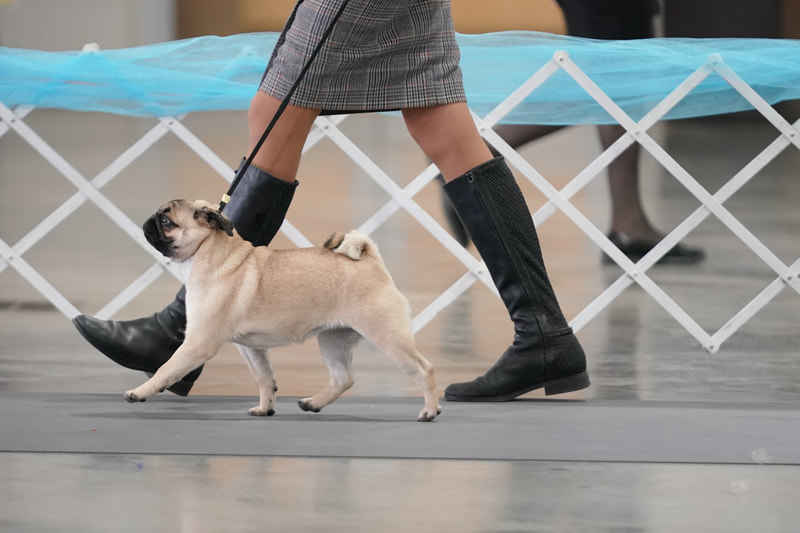
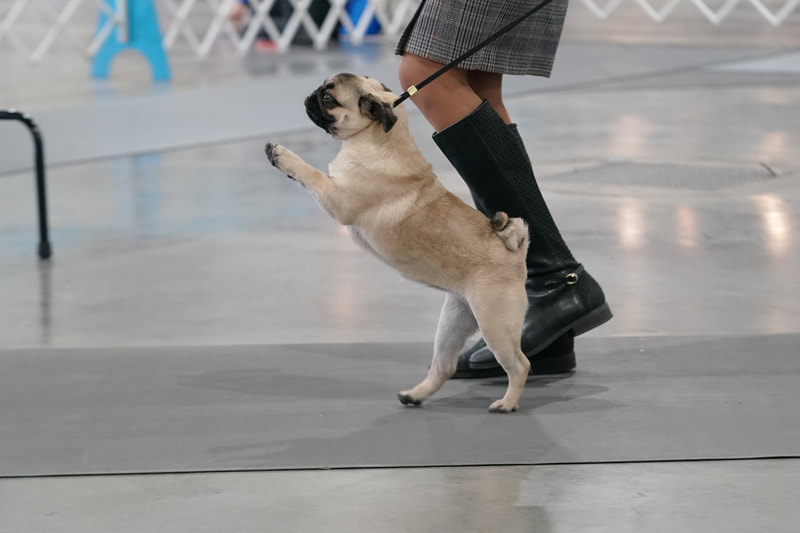


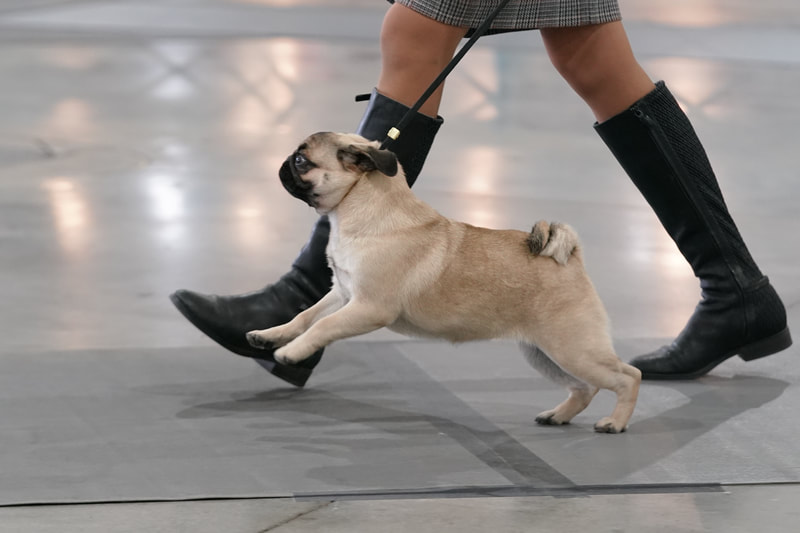
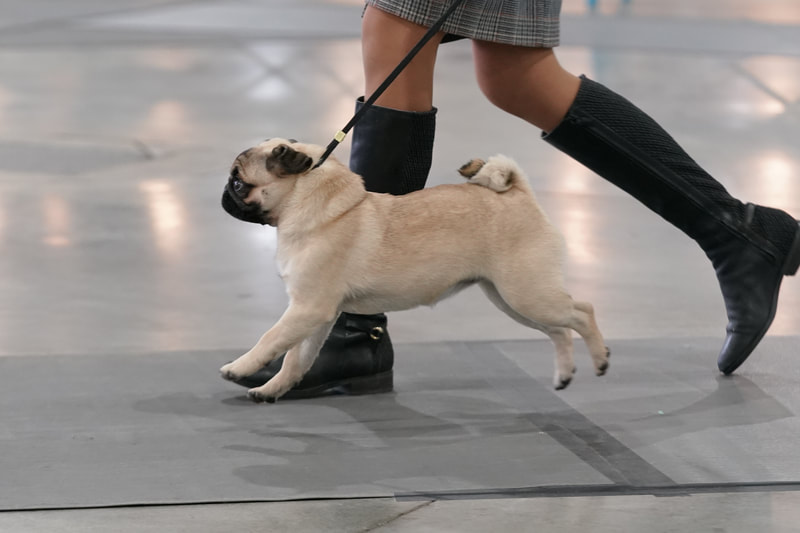


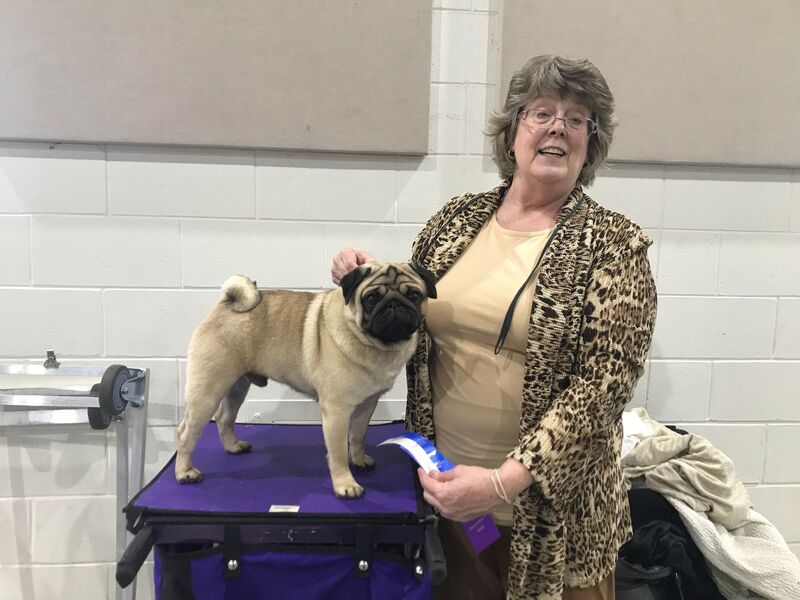

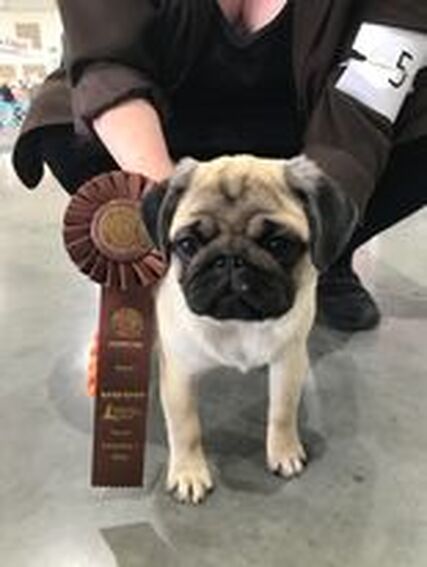


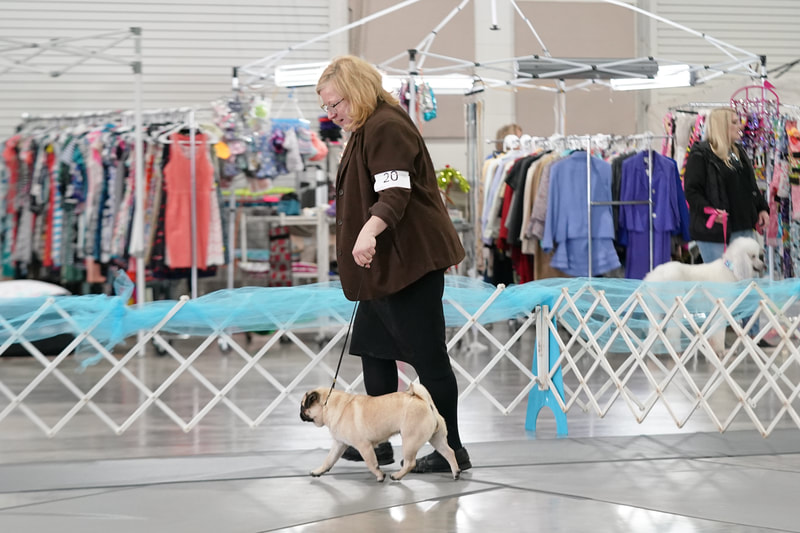









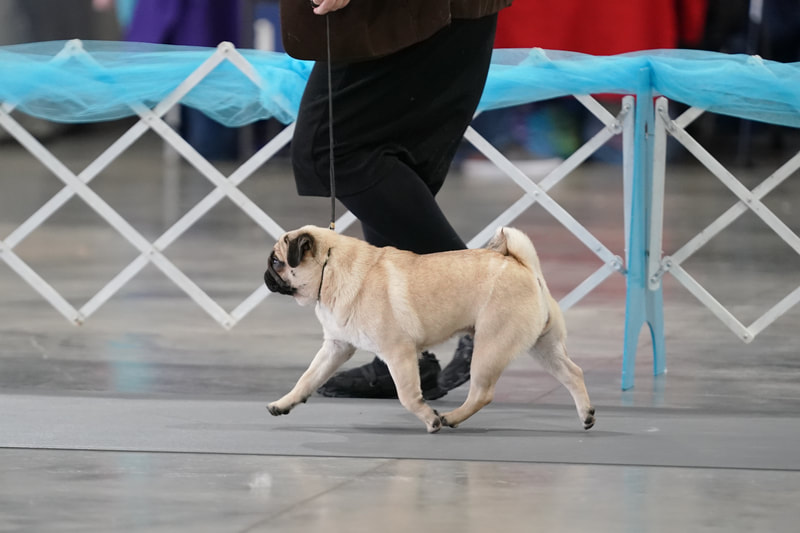

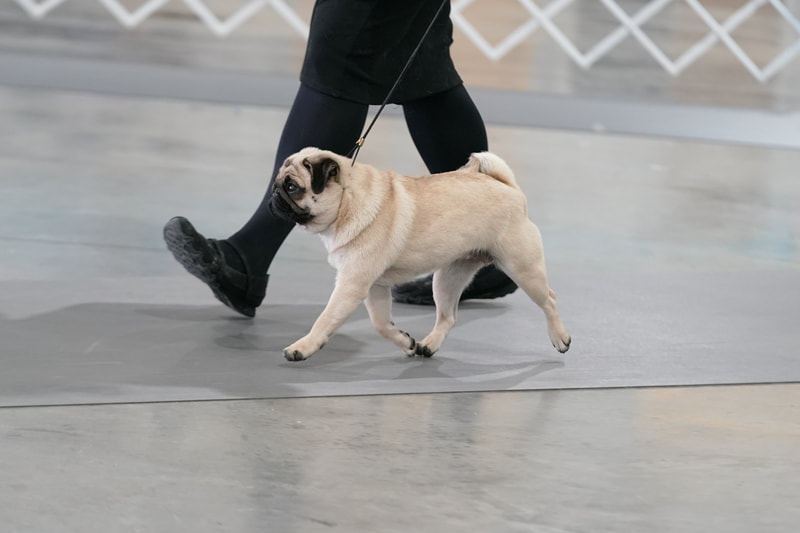
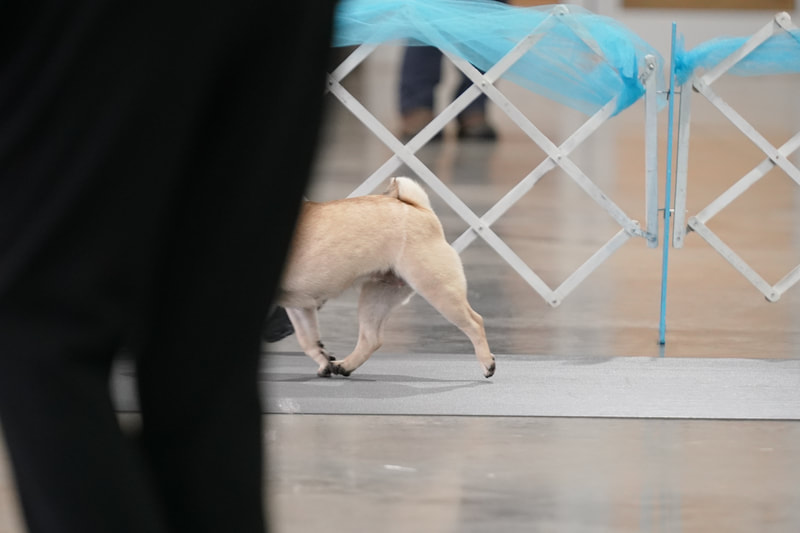

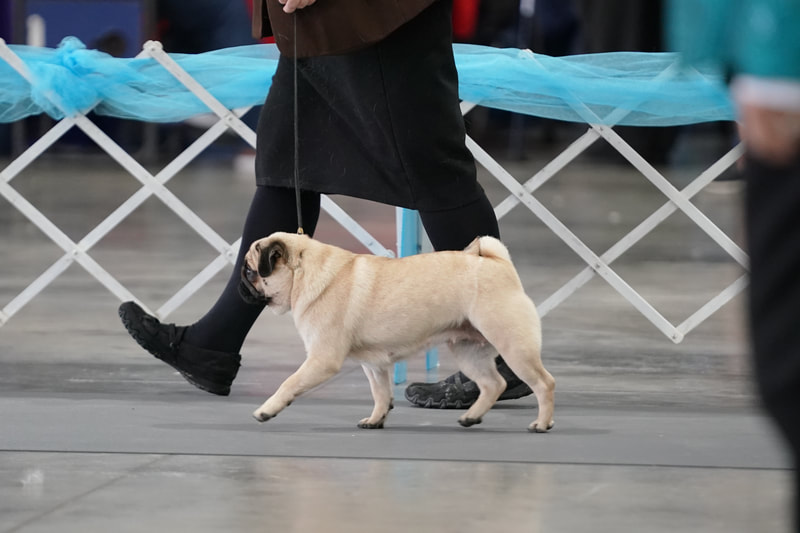



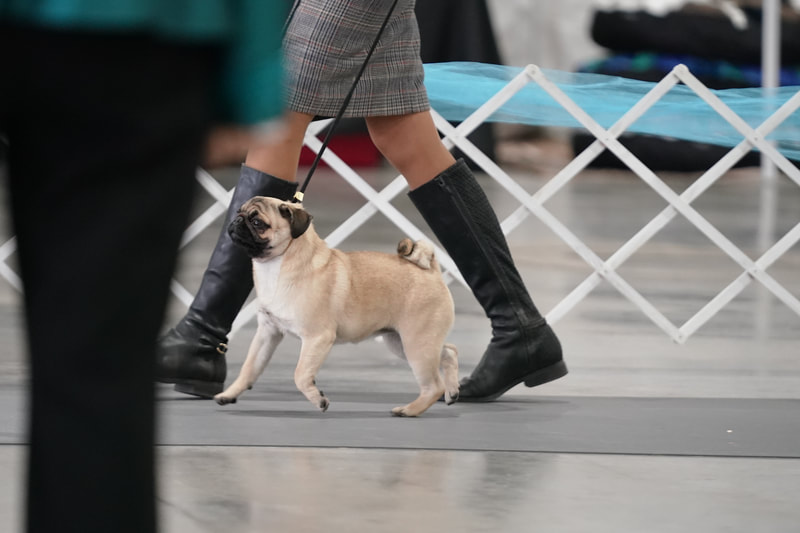
 RSS Feed
RSS Feed